March 2024
1. Headline indicators
Employment in January 2024 is slightly up by 600 on the previous month but down by 20,700 on the August-October 2023 quarter, to 33,175,000. The employment rate for those aged 16-64 fell slightly to 75.0%, from 75.1% in the last quarter.
Economic inactivity for those aged 16-64 went up by 44,100 on the previous quarter to 9,250,000. The economic inactivity rate remained the same at 21.8%.
Unemployment (for those aged 16-64) fell by 6,100 compared with the previous quarter to 1,338,000. The unemployment rate fell to 4.0% from 4.1% in the previous quarter.
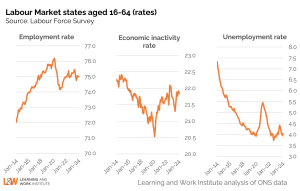
2. Nominal pay rises continue to outstrip inflation, but are starting to fall
The latest data show average regular earnings grew by 6.1% in the year to January 2024, down from 6.2% in December 2023 and the post-pandemic peak of 7.9% in August 2023. For public sector workers average regular earnings grew by 5.9% in the year to January 2024, while average regular earnings grew by 6.1% for private sector workers. After taking account of inflation, real regular earnings went up by 1.8% (3-month average change) in the year to January 2024, with the single month data for January showing a real-terms increase of 1.6% over the year.
The rate of inflation has been falling since May 2023, but CPIH has remained static at 4.2% since November 2023. In the year to January 2023 core CPIH (excluding energy, food, alcohol and tobacco) rose by 5.1%, slightly lower than the increase seen in the year to December 2023 (5.2%). Inflation in areas like Food and non-alcoholic beverages, Health, Communication and Restaurants and hotels is still very high and inflation in the UK remains above that in other countries in the G7. The United States is currently experiencing an inflation rate of 3.1% while the Eurozone average is 2.8%. Weak growth since the global financial crisis means average earnings are around £12,000 per year lower than if pre-crisis trends had continued.
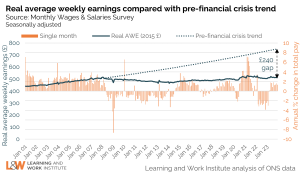
3. There are fewer potential workers for employers to recruit, with 903,000 fewer over 50s in the labour market since the pandemic started
Recruitment has been more challenging for employers since the pandemic because of rises in economic inactivity – people leaving the labour market. The number of people aged 50 to 64 who are economically inactive has increased by 7.5% since the pandemic started.
Economic inactivity has been fairly static since the Summer of 2023, with the rate standing at 21.8% for those aged 16-64 in November 2023 to January 2024 – the same as in the previous quarter. Overall, the number of those aged 16 to 64 who are economic inactive is 700,000 higher than pre-pandemic, yet only one in ten out-of-work older people and people with a disability get employment support each year. The Government needs to extend employment support to more people outside the labour market and employers need to think about recruitment and job design to attract and retain staff.
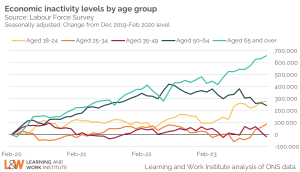
4. The proportion of 18- to 24-year-olds not in employment or full-time education has risen over the past year
The unemployment rate for young people aged between 16 and 24 in the November 2023 to January 2024 quarter was 12.1%, 1.0 percentage points higher than the rate in the same quarter one year earlier (11.1 per cent). The number of young people aged between 16 and 24 who are not in employment or full-time education currently stands at 1,062,000. Whilst the percentage of those aged 16 to 17 who were not in employment or full-time education fell from 8.9% in November 2022 to January 2023 to 8.3% one year later, the percentage of 18- to 24-year-olds who were not in employment or full-time education rose from at 16.2% to 16.8% over the same period. Our Youth Opportunity Index gives a detailed portrait of the opportunities and challenges for every young person broken down by local education authority.
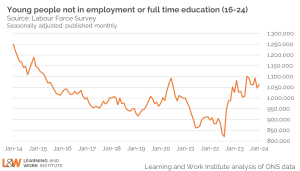
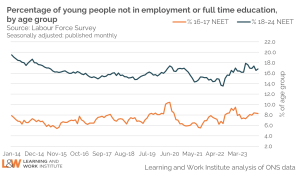
5. Vacancies are continuing to fall, but 1.8 million economically inactive want a job
Headline vacancies in the December 2023 to February 2024 quarter were down by 20,000 on the previous month, at 908,000, and 43,000 lower than in the previous quarter. The headline ONS vacancy figure is both seasonally adjusted and a three-month average. Using the official measure of unemployment, there are 1.5 unemployed people for every vacancy. However, there are an additional 1.8 million people who are economically inactive but want a job. Extending employment support to this group would potentially ease recruitment pressures for employers.
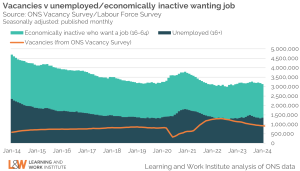
6. Numbers claiming unemployment-related benefits continue to exceed the ILO measure of unemployment
Unemployment in the November 2023 to January 2024 quarter was 1,359,000. The quarterly headline figure has fallen by 8,000 since the August to October quarter of 2023, but is up by 39,000 from last month’s published level. The experimental single-month estimate showed a rise in unemployment of 103,000 between December 2023 and January 2024. The ONS figure for claimant unemployed is 1,585,000, up by 16,800 on last month. The number of unemployed people who are claiming unemployment-related benefits is now 226,000 higher than the number unemployed on the official measure.
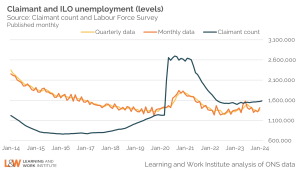
7. Unemployment rate much higher for young people than for those aged 25+
The 16- to 24-year-old unemployment rate (including students) was 12.1% of the economically active in the November 2023 to January 2024 quarter. The rate for those aged 25 to 49 was 3.1%. For those aged 50 and over it is 2.3%. The quarterly change is -0.03 percentage points for 16- to 24-year-olds and -0.01 percentage points for 25- to 49-year-olds. There was no change in the unemployment rate for the over-50s compared with the previous quarter.
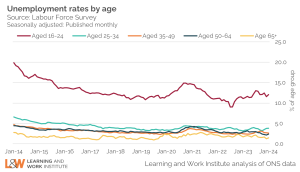
8. Long-term unemployment rising for those aged 25+
Youth long-term unemployment (which can include students) is down by 13,000 over the last quarter and stood at 146,000 in the November 2023 to January 2024 quarter. Long-term unemployment for young people is normally counted as being unemployed for six months or more. Adult long-term unemployment on the survey measure was 207,000 in the November 2023 to January 2024 quarter. The number of people aged 25 and over out of work for 12 months was 26,000 higher in the most recent quarter than in the previous quarter (August to October 2023).
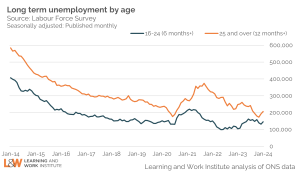
Subscribe to our newsletter to get sent our in-depth labour market analysis each month
Register for our Employment and Skills Convention 2024
